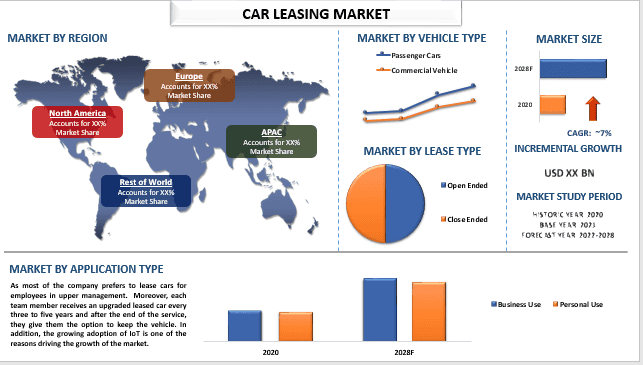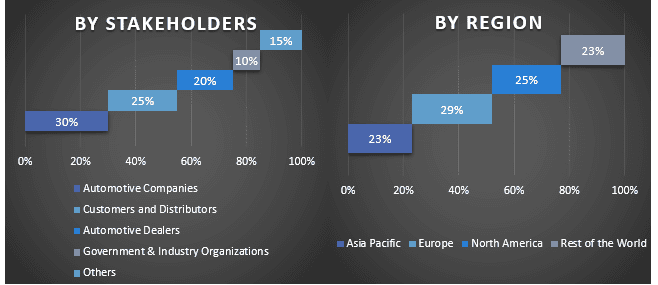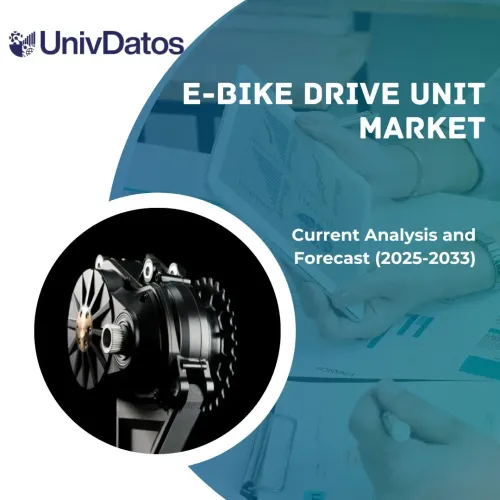- Startseite
- Über uns
- Industrie
- Dienstleistungen
- Lesen
- Kontaktieren Sie uns
Markt für Fahrzeugleasing: Aktuelle Analyse und Prognose (2022-2028)
Schwerpunkt auf Anwendungsart (geschäftliche und private Nutzung); Leasingtyp (offenes und geschlossenes Leasing); Fahrzeugtyp (Personenwagen und Nutzfahrzeuge) und Region/Land

Es wird erwartet, dass der globale Car-Leasing-Markt im Prognosezeitraum mit einer beträchtlichen Rate von etwa 7 % wächst. Ein Leasingvertrag ist eine Art Vertrag, bei dem sich der Kunde bereit erklärt, das Fahrzeug für einen vorab festgelegten Zeitraum gegen regelmäßige Zahlungen zu nutzen. Nutzer von Car-Leasing können verschiedene Vorteile nutzen, wie z. B. monatliche Zahlungen und den Erhalt neuer Fahrzeuge alle paar Jahre. Darüber hinaus expandiert der Fahrzeugleasingmarkt aufgrund der Einführung des IoT, intelligenter Stadtinitiativen, der rasanten Urbanisierung und der Übernahme des Car-Leasing durch Unternehmen. Darüber hinaus arbeiten Unternehmen zusammen, um die globale Mobilitätsabdeckung zu verbessern und an den besten Lösungen für die Kundenfreundlichkeit zu arbeiten. So hat Avis India beispielsweise im August 2020 AVIS Flexi 12 auf den Markt gebracht, eine alternative Lösung zu Car-Subscription-Mobilitätsdiensten. Der Vorteil dieses Produkts besteht darin, dass die Kunden ihr bevorzugtes neues Auto auswählen und es auf dem privaten Nummernschild im Namen von Avis registrieren können.
ORIX Corporation, Sixt Rent A Car LLC, ALD Automotive, Hertz Global Holdings Inc, Arval, LeasePlan, Alphabet, Lex Autolease, Deutsche Leasing AG, Wilmar Inc. sind einige der wichtigsten Akteure auf dem Markt. Mehrere M&As sowie Partnerschaften wurden von diesen Akteuren eingegangen, um Kunden mit Hightech- und innovativen Produkten/Technologien zu unterstützen.
Im Bericht dargestellte Einblicke
„Unter den Anwendungsarten wird die Kategorie der geschäftlichen Nutzung im Prognosezeitraum ein robustes CAGR verzeichnen“
Basierend auf der Anwendungsart ist der Markt in geschäftliche und private Nutzung unterteilt. Es wird erwartet, dass die Kategorie der geschäftlichen Nutzung im Prognosezeitraum einen bedeutenden Anteil am Markt halten wird. Da die meisten Unternehmen es vorziehen, Autos für Mitarbeiter im oberen Management zu leasen. Darüber hinaus erhält jedes Teammitglied alle drei bis fünf Jahre ein verbessertes geleastes Auto und nach Ablauf des Service haben sie die Möglichkeit, das Fahrzeug zu behalten. Darüber hinaus ist die zunehmende Einführung des IoT einer der Gründe für das Wachstum des Marktes.
„Unter den Leasingarten wird das Open-End im Jahr 2020 einen bedeutenden Anteil am Markt halten“
Basierend auf der Leasingart wird der Markt in Open-End und Close-End unterteilt. Unter diesen wird erwartet, dass das Open-End im Prognosezeitraum einen bedeutenden Anteil am Markt halten wird. Beim Open-End muss ein Leasingnehmer am Ende dieses Leasings eine einmalige Zahlung leisten, was eine Art Mietvertrag darstellt. Diese Art von Leasing wird hauptsächlich für Geschäftszwecke bevorzugt. Darüber hinaus ermöglicht das Open-End dem Benutzer, die volle Autorisierung des Fahrzeugs in Bezug auf unbegrenzte Kilometerleistung gemäß den Leasingbedingungen zu erhalten.
„Unter den Fahrzeugtypen wird das Personenfahrzeug im Jahr 2020 einen bedeutenden Anteil am Markt halten“
Basierend auf dem Fahrzeugtyp wurde der Car-Leasing-Markt in Personenkraftwagen und Nutzfahrzeuge unterteilt. Es wird erwartet, dass die Kategorie der Personenkraftwagen im Prognosezeitraum ein höheres Wachstum verzeichnen wird. Dies ist hauptsächlich auf die Zunahme der Produktion von Personenkraftwagen und das steigende Pro-Kopf-Einkommen der Bevölkerung zurückzuführen. Darüber hinaus ist die wachsende Zahl von Herstellern in neuen Schwellenländern der Haupttreiber für die hohe Nachfrage nach Personenkraftwagen.
„Nordamerika wird einen bedeutenden Anteil am Markt halten“
Für ein besseres Verständnis der Marktakzeptanz der Car-Leasing-Industrie wird der Markt basierend auf seiner weltweiten Präsenz in den Ländern wie Nordamerika (USA, Kanada, Rest von Nordamerika), Europa (Deutschland, Großbritannien, Frankreich, Spanien, Italien, Rest von Europa), Asien-Pazifik (China, Japan, Indien, Rest von Asien-Pazifik), Rest der Welt analysiert. Es wird erwartet, dass Nordamerika im Prognosezeitraum mit einer beträchtlichen CAGR wachsen wird. Dies ist hauptsächlich auf das wachsende Bewusstsein der Nutzer und die steigenden Kosten des Autobesitzes zurückzuführen, und die niedrigen Zinssätze der Leasinggesellschaften sind die Faktoren, die das Wachstum des Marktes antreiben.
Gründe für den Kauf dieses Berichts:
- Die Studie umfasst eine Marktdimensionierungs- und Prognoseanalyse, die von authentifizierten wichtigen Branchenexperten validiert wurde.
- Der Bericht bietet einen schnellen Überblick über die Gesamtleistung der Branche auf einen Blick.
- Der Bericht enthält eine eingehende Analyse der wichtigsten Branchenkollegen mit einem primären Fokus auf wichtige Geschäftskennzahlen, Produktportfolio, Expansionsstrategien und aktuelle Entwicklungen.
- Detaillierte Untersuchung der Treiber, Beschränkungen, wichtigsten Trends und Chancen, die in der Branche vorherrschen.
- Die Studie deckt den Markt umfassend über verschiedene Segmente hinweg ab.
- Tiefgreifende regionale Analyse der Branche.
Anpassungsoptionen:
Der globale Car-Leasing-Markt kann weiter an die Anforderungen oder jedes andere Marktsegment angepasst werden. Darüber hinaus versteht UMI, dass Sie möglicherweise Ihre eigenen geschäftlichen Anforderungen haben. Zögern Sie daher nicht, sich mit uns in Verbindung zu setzen, um einen Bericht zu erhalten, der vollständig Ihren Anforderungen entspricht.
Inhaltsverzeichnis
Forschungsansatz für die Marktanalyse zum Autoleasingmarkt (2022-2028)
Die Analyse des historischen Marktes, die Schätzung des aktuellen Marktes und die Prognose des zukünftigen Marktes des globalen Autoleasingmarktes waren die drei wichtigsten Schritte, die unternommen wurden, um die Akzeptanz von Autoleasing in wichtigen Regionen weltweit zu erstellen und zu analysieren. Umfassende Sekundärforschung wurde durchgeführt, um die historischen Marktzahlen zu sammeln und die aktuelle Marktgröße zu schätzen. Zweitens wurden zahlreiche Erkenntnisse und Annahmen berücksichtigt, um diese Erkenntnisse zu validieren. Darüber hinaus wurden umfassende Primärinterviews mit Branchenexperten entlang der Wertschöpfungskette des globalen Autoleasingmarktes geführt. Nach der Annahme und Validierung der Marktzahlen durch Primärinterviews verwendeten wir einen Top-Down-/Bottom-Up-Ansatz, um die vollständige Marktgröße zu prognostizieren. Danach wurden Methoden zur Marktaufschlüsselung und Datentriangulation angewendet, um die Marktgröße von Segmenten und Untersegmenten der Branche zu schätzen und zu analysieren. Die detaillierte Methodik wird im Folgenden erläutert:
Analyse der historischen Marktgröße
Schritt 1: Eingehende Untersuchung von Sekundärquellen:
Es wurde eine detaillierte Sekundärstudie durchgeführt, um die historische Marktgröße des Autoleasingmarktes durch unternehmensinterne Quellen wie Jahresberichte und Finanzberichte, Performance-Präsentationen, Pressemitteilungen usw. und externe Quellen wie Fachzeitschriften, Nachrichten und Artikel, Regierungsveröffentlichungen, Wettbewerbsveröffentlichungen, Branchenberichte, Datenbanken von Drittanbietern und andere glaubwürdige Veröffentlichungen zu erhalten.
Schritt 2: Marktsegmentierung:
Nachdem wir die historische Marktgröße des Autoleasingmarktes erhalten hatten, führten wir eine detaillierte Sekundäranalyse durch, um historische Markteinblicke und Anteile für verschiedene Segmente und Untersegmente für wichtige Regionen zu sammeln. Wichtige Segmente sind im Bericht als Anwendungsart, Leasingart und Fahrzeugtyp enthalten. Weiterhin wurden Analysen auf Länderebene durchgeführt, um die allgemeine Akzeptanz von Testmodellen in dieser Region zu bewerten.
Schritt 3: Faktorenanalyse:
Nachdem wir die historische Marktgröße verschiedener Segmente und Untersegmente erfasst hatten, führten wir eine detaillierte Faktorenanalyse durch, um die aktuelle Marktgröße des Autoleasingmarktes zu schätzen. Weiterhin führten wir eine Faktorenanalyse unter Verwendung abhängiger und unabhängiger Variablen wie Anwendungsart, Leasingart und Fahrzeugtyp des Autoleasings durch. Eine gründliche Analyse wurde für Nachfrage- und Angebotsseitenszenarien unter Berücksichtigung von Top-Partnerschaften, Fusionen und Übernahmen, Geschäftsausweitungen und Produkteinführungen im Autoleasingmarktsektor auf der ganzen Welt durchgeführt.
Aktuelle Marktzgrößenschätzung & Prognose
Aktuelle Marktgrößenbestimmung: Basierend auf verwertbaren Erkenntnissen aus den oben genannten 3 Schritten gelangten wir zur aktuellen Marktgröße, den wichtigsten Akteuren auf dem globalen Autoleasingmarkt und den Marktanteilen der Segmente. Alle erforderlichen prozentualen Anteile und Marktaufschlüsselungen wurden unter Verwendung des oben genannten sekundären Ansatzes ermittelt und durch Primärinterviews verifiziert.
Schätzung & Prognose: Für die Marktschätzung und -prognose wurden verschiedenen Faktoren, einschließlich Treiber & Trends, Einschränkungen und Chancen, die den Stakeholdern zur Verfügung stehen, Gewichte zugewiesen. Nach der Analyse dieser Faktoren wurden relevante Prognosetechniken, d. h. der Top-Down-/Bottom-Up-Ansatz, angewendet, um die Marktprognose für 2028 für verschiedene Segmente und Untersegmente in den wichtigsten Märkten weltweit zu erstellen. Die zur Schätzung der Marktgröße angewandte Forschungsmethodik umfasst:
- Die Marktgröße der Branche in Bezug auf den Umsatz (USD) und die Akzeptanzrate des Autoleasingmarktes in den wichtigsten Märkten im Inland
- Alle prozentualen Anteile, Aufteilungen und Aufschlüsselungen von Marktsegmenten und Untersegmenten
- Wichtige Akteure auf dem globalen Autoleasingmarkt in Bezug auf die angebotenen Produkte. Auch die von diesen Akteuren angewandten Wachstumsstrategien, um im schnell wachsenden Markt zu bestehen
Validierung von Marktgröße und -anteilen
Primärforschung: Es wurden ausführliche Interviews mit den Key Opinion Leaders (KOLs) geführt, einschließlich Top-Level-Executives (CXO/VPs, Vertriebsleiter, Marketingleiter, Betriebsleiter, Regionalleiter, Länderleiter usw.) in wichtigen Regionen. Die Ergebnisse der Primärforschung wurden dann zusammengefasst und eine statistische Analyse durchgeführt, um die aufgestellte Hypothese zu beweisen. Die Erkenntnisse aus der Primärforschung wurden mit den Sekundärforschungsergebnissen zusammengeführt, wodurch Informationen in verwertbare Erkenntnisse umgewandelt wurden.
Aufteilung der Primärteilnehmer in verschiedene Regionen

Markt Engineering
Die Datentriangulationstechnik wurde angewendet, um die Gesamtmarktschätzung abzuschließen und präzise statistische Zahlen für jedes Segment und Untersegment des globalen Autoleasingmarktes zu erhalten. Die Daten wurden in mehrere Segmente & Untersegmente aufgeteilt, nachdem verschiedene Parameter und Trends in den Bereichen Anwendungsart, Leasingart und Fahrzeugtyp auf dem globalen Autoleasingmarkt untersucht wurden.
Das Hauptziel der Global Car Leasing Market Study
Die aktuellen und zukünftigen Markttrends des globalen Autoleasingmarktes wurden in der Studie genau bestimmt. Investoren können strategische Erkenntnisse gewinnen, um ihre Entscheidungen für Investitionen auf der Grundlage der in der Studie durchgeführten qualitativen und quantitativen Analyse zu treffen. Aktuelle und zukünftige Markttrends bestimmten die Gesamtattraktivität des Marktes auf regionaler Ebene und bieten den Industrieteilnehmern eine Plattform, um den unerschlossenen Markt zu nutzen und von einem First-Mover-Vorteil zu profitieren. Weitere quantitative Ziele der Studien sind:
- Analyse der aktuellen und prognostizierten Marktgröße des Autoleasingmarktes in Bezug auf den Wert (USD). Analysieren Sie auch die aktuelle und prognostizierte Marktgröße verschiedener Segmente und Untersegmente
- Segmente in der Studie umfassen die Bereiche Anwendungsart, Leasingart und Fahrzeugtyp.
- Definition und Analyse des regulatorischen Rahmens für das Autoleasing
- Analyse der Wertschöpfungskette unter Einbeziehung verschiedener Vermittler sowie Analyse des Kunden- und Wettbewerberverhaltens der Branche.
- Analyse der aktuellen und prognostizierten Marktgröße des Autoleasingmarktes für die Hauptregion.
- Wichtige Länder der in dem Bericht untersuchten Regionen sind Asien-Pazifik, Europa, Nordamerika und der Rest der Welt.
- Unternehmensprofile des Autoleasingmarktes und die von den Marktteilnehmern angewandten Wachstumsstrategien, um im schnell wachsenden Markt zu bestehen
- Tiefgehende Analyse der Branche auf regionaler Ebene
Verwandt Berichte
Kunden, die diesen Artikel gekauft haben, kauften auch










